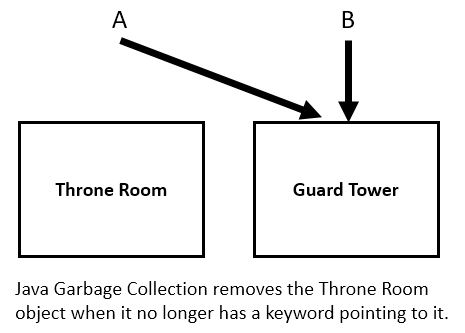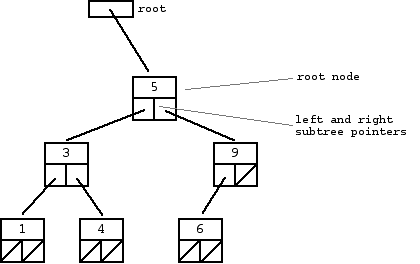Java Chapter 15 - Linked Lists and Trees
15.1 Java
References
Object keywords are references which
is an address that tells where the object's class variables and objects are
stored. Unlike C++, Java does not have pointers which allows variables to
store memory addresses and can be changed to point to arbitrary addresses.
We can, however, use these references in some ways like pointers to create
various data structures. Look at the code below. Only one object is
being created since there's only one
new
statement. Both A and B reference the same object. Therefore, when
you increment B.Apples, A.Apples shows the same value.
|
reference.java |
public class reference
{
public static void main(String[] args)
{
Stuff A = new Stuff();
A.Apples = 7;
Stuff B = A;
B.Apples++;
System.out.println(A.Apples);
}
}
class Stuff
{
int Apples;
}
|
Output
8 |
The code below shows how to use
objects and references to configure the rooms of a castle that you can be travel
through. Entrance is the keyword that points to the first object -
Gatehouse. T is a temporary keyword used to create the Great Hall and Throne
Room objects. Each Room has a pointer to another Room - North, South,
East, and West. These can be connected
|
castle.java |
 |
public class castle
{
public static void main(String[] args)
{
Room Entrance = new Room("Gatehouse");
Room T = new Room("Great Hall");
T.North = Entrance;
Entrance.South = T;
T = new Room("Throne Room");
T.West = Entrance.South;
Entrance.South.East = T;
System.out.println(Entrance.South.East.RoomName);
System.out.println(Entrance.South.East.West.North.RoomName);
}
}
class Room
{
String RoomName;
Room North, South, East, West;
Room (String TheRoomName)
{ RoomName = TheRoomName; }
}
|
Output
Throne Room
Gatehouse |
Java Garbage Collection
Java has built in memory management which frees the programmer from the
task of reclaiming memory of unused objects. If you create an
object and reassign the keyword that points to it, Java's garbage
collection removes the object from memory. For example:
Room A = new Room ("Throne
Room");
Room B = new Room ("Guard Tower");
A = B; |
 |
15.2
Linked List
A linked list is a data structure
made of nodes where each node has a pointer to the next. The last node's
pointer is null.

On average, the time it takes to locate an item in a linked list is O(n).
In Java, you can implement a linked list using Node classes. Notice that
Next is a pointer to the next Node.
class Node
{
int Data;
Node Next;
Node()
{
Next = null;
}
}
To insert a new node at the head of the list, you could do the following:
Node T = new Node();
T.Data = NewData;
if (Head == null)
// first Node of the
list
{
Head = T;
}
else
// insert node between
Head and first Node
{
Node THead = Head;
T.Next = THead;
Head = T;
}
15.3
Binary Tree
A binary tree is a data structure
made of nodes, where each node contains a left pointer, a right pointer, and a
data element. If the tree is empty, then the root pointer is null.
A recursive definition of this data structure is: a binary tree is either
empty (null pointer), or a single node where the left and right pointers each
point to another binary tree.
A binary search tree (BST) is an ordered binary tree where all the elements in
the left search tree are <= the node and all the elements in the right search
tree are >= node.

On average, a BST can be searched in O(log n).
In Java, you can implement a BST using Node classes. Notice that Left and
Right are pointers to another Node.
class Node
{
int Data;
Node Left, Right;
Node()
{
Left = null;
Right = null;
}
}
Implementing a binary tree of integers using the Node class could use
have these recursive methods:static boolean Locate(Node TheNode, int TheData)
{
if (TheNode == null)
return false;
if (TheNode.Data == TheData)
return true;
else if (TheNode.Data > TheData) // traverse tree to the left
return Locate(TheNode.Left,TheData);
else if (TheNode.Data < TheData) // traverse tree to the right
return Locate(TheNode.Right,TheData);
else if (TheNode.Data > TheData && TheNode.Left == null)
return false;
else if (TheNode.Data < TheData && TheNode.Right == null)
return false;
return false; // Java needs a default return
}
static void Insert(Node TheNode, int NewData)
{
if (TheNode.Data > NewData && TheNode.Left == null) // Left is null - add new node on left
{
Node T = new Node();
T.Data = NewData;
TheNode.Left = T;
}
else if (TheNode.Data < NewData && TheNode.Right == null) // Right is null - add new node on right
{
Node T = new Node();
T.Data = NewData;
TheNode.Right = T;
}
else if (TheNode.Data > NewData && TheNode.Left != null) // Left isn't null - recurse to left
Insert(TheNode.Left, NewData);
else if (TheNode.Data < NewData && TheNode.Right != null) // Right isn't null - recurse to right
Insert(TheNode.Right, NewData);
}


